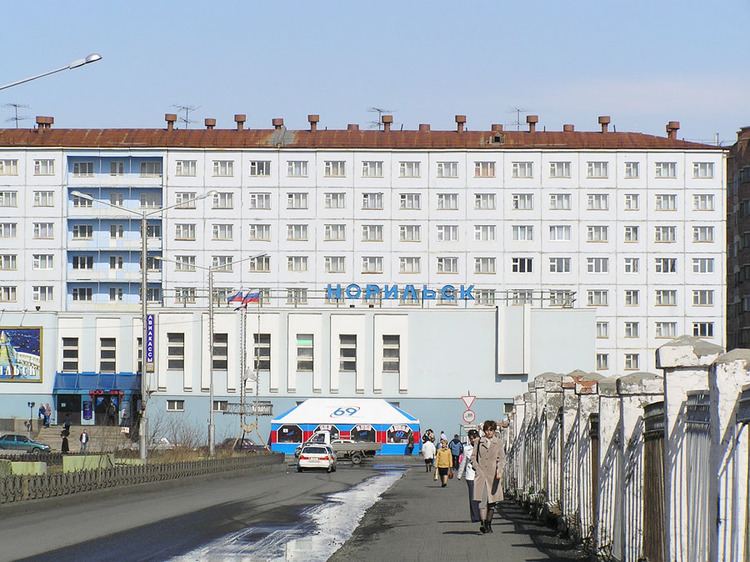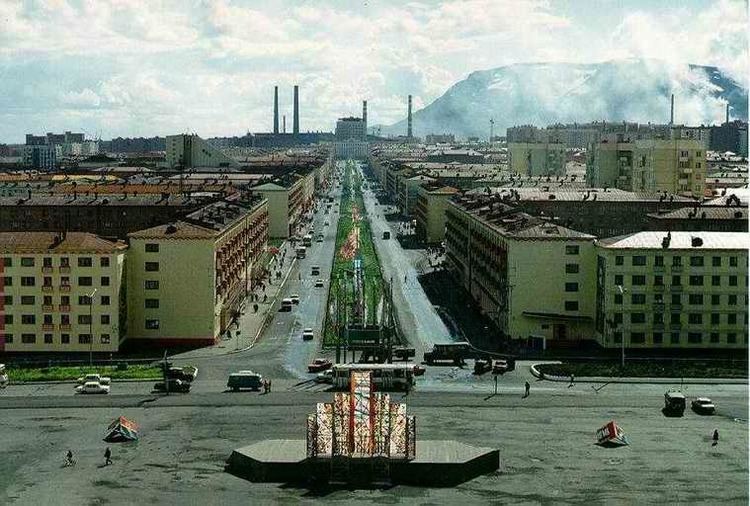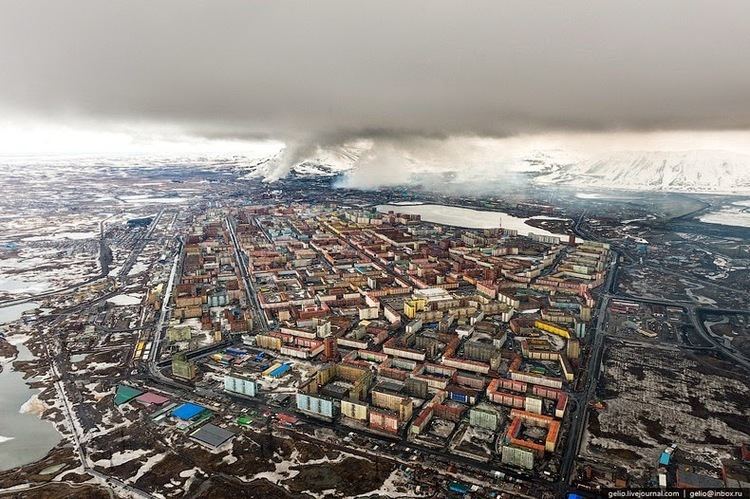Founded 1935 | Population 175,365 (2010) | |
 | ||
Map of Norilsk
Norilsk (Russian: Норильск; [nɐˈrʲilʲsk]) is an industrial city in Krasnoyarsk Krai, Russia, located above the Arctic Circle, east of the Yenisei River and south of the western Taymyr Peninsula. It has a permanent population of 175,000. With temporary inhabitants included, its population reaches 220,000.
Contents
- Map of Norilsk
- Norilsk russias most polluted city interview with photographer elena chernyshova
- Russia s norilsk arctic city of extreme cold massive pollution
- History
- Administrative and municipal status
- Religion
- Population
- Geography climate and natural environment
- Pollution
- Norilsk Talnakh nickel deposits
- Economy
- Culture
- Twin towns and sister cities
- Notable people
- References

Norilsk was closed in November 2001 to all non-Russians, except for Belarusians.

It is the world's northernmost city with more than 100,000 inhabitants and the second largest city (after Murmansk) inside the Arctic Circle. Norilsk, Yakutsk, and Vorkuta are the only large cities in the continuous permafrost zone.

Norilsk russias most polluted city interview with photographer elena chernyshova
Russia s norilsk arctic city of extreme cold massive pollution
History

Norilsk was founded at the end of the 1920s, but the official date of founding is traditionally 1935, when Norilsk was expanded as a settlement for the Norilsk mining-metallurgic complex and became the center of the Norillag system of GULAG labor camps. It was granted urban-type settlement status in 1939 and town status in 1953.
Norilsk is located between the West Siberian Plain and Central Siberian Plateau at the foot of the 1,700-meter (5,600 ft) high Putoran Mountains, on some of the largest nickel deposits on Earth. Consequently, mining and smelting ore are the major industries. Norilsk is the center of a region where nickel, copper, cobalt, platinum, palladium and coal are mined. Mineral deposits in the Siberian Craton had been known for two centuries before Norilsk was founded, but mining began only in 1939, when the buried portions of the Norilsk-Talnakh intrusions were found beneath mountainous terrain.
Talnakh is the major mine/enrichment site now from where an enriched ore emulsion is pumped to Norilsk metallurgy plants.
To support the new city, a railway to the port of Dudinka on the Yenisei River was established, first as a narrow-gauge line (winter 1935–36), later as 1,520 mm (4 ft 11 27⁄32 in) Russian standard gauge line (completed in the early 1950s). From Dudinka, enriched nickel and copper are transported to Murmansk by sea and, then, to the Monchegorsk enrichment and smelting plant on the Kola Peninsula, while more precious content goes up the river to Krasnoyarsk. This transportation only takes place during the summer. The port of Dudinka is closed and dismantled during spring's ice barrier floods of up to 20 meters (66 ft) in late May (a typical spring occurrence on all Siberian rivers).
In the early 1950s, another railway was under construction from the European coal city Vorkuta via the Salekhard/Ob River, and Norilsk got a spacious railway station built in the expectation of train service to Moscow, but construction stopped after Joseph Stalin died.
According to the archives of Norillag, 16,806 prisoners died in Norilsk under the conditions of forced labor, starvation and intense cold during the existence of the camp (1935–1956). Fatalities were especially high during the war years of 1942–1944 when food supplies were particularly scarce. Prisoners organised the nonviolent Norilsk uprising in 1953. Unknown but significant numbers of prisoners continued to serve and die in the mines until around 1979. Norilsk-Talknakh continues to be a dangerous mine to work in: according to the mining company, there were 2.4 accidents per thousand workers in 2005. Since the early 2000s the city has been rebuilding itself and reshaping its image. Bars on the top floors of apartments are appearing and buildings are getting renovated.
Administrative and municipal status
Within the framework of administrative divisions, it is, together with the urban-type settlement of Snezhnogorsk, incorporated as the krai city of Norilsk—an administrative unit with the status equal to that of the districts. As a municipal division, the krai city of Norilsk is incorporated as Norilsk Urban Okrug.
Religion
There is a mosque in Norilsk. Built in 1998 belonging to the local Tatar community, it is considered to be the northernmost Muslim prayer house in the world. There is also a Russian Orthodox cathedral, several Russian Orthodox churches and a Ukrainian Orthodox church.
Population
The population of Norilsk is 175,365 (2010 Census) after the fall of the USSR, its population went down by 40,000, but this was offset by the subsequent merger of the towns of Kayerkan and Talnakh into Norilsk, maintaining a permanent population of 175,000. Including temporary residents, the population reaches 220,000 people.
Geography, climate, and natural environment
Norilsk is the world's northernmost city with more than 100,000 inhabitants and the second largest city (after Murmansk) inside the Arctic Circle. Norilsk, Yakutsk and Vorkuta are the only large cities in the continuous permafrost zone. It lies between Taymyrsky Dolgano-Nenetsky District to the north, and Turukhansky District to the south. Norilsk has an extremely harsh subarctic climate (Köppen Dfc), and is covered with snow for about 250–270 days a year, with snow storms for about 110–130 days. The "midnight sun" is above the horizon from 21 May to 24 July, and the period when the sun does not rise, polar night, is from approximately 30 November to 13 January. Temperatures can sometimes rise above 25 °C (77 °F) in July.
Much of the surrounding areas are naturally treeless tundra. Only a few trees exist in Norilsk.
Pollution
Nickel ore is smelted on site at Norilsk. The smelting is directly responsible for severe pollution, generally acid rain and smog. By some estimates, 1 percent of global emissions of sulfur dioxide comes from Norilsk's nickel mines. Heavy metal pollution near Norilsk is so severe that mining the surface soil is now economically feasible due to the soil acquiring such high concentrations of platinum and palladium.
The Blacksmith Institute included Norilsk in its 2007 list of the ten most polluted places on Earth. The list cites air pollution by particulates (including radioisotopes strontium-90, and caesium-137 and metals nickel, copper, cobalt, lead and selenium) and by gases (such as nitrogen and carbon oxides, sulfur dioxide, phenols and hydrogen sulfide). The Institute estimates four million tons of cadmium, copper, lead, nickel, arsenic, selenium and zinc are released into the air every year.
The Russian Federal State Statistics Service named Norilsk the most polluted city in Russia. In 2010, Norilsk produced 1.924 million tons of carbon pollutants, nearly six times more than the 333 thousand tons generated by Russia's second most polluted city, Cherepovets.
According to an April 2007 BBC News report, Norilsk Nickel accepted responsibility for what had happened to the forests, and insisted they were taking action to cut the pollution. For the period up to 2015–2020 the company expects to reduce sulfur dioxide emissions by approximately two-thirds, but claims it is hard to guarantee this pace of reduction because they are still developing the technology.
In September 2016, images surfaced on social media of the nearby Daldykan River which had been turned red. Russia's Environment Ministry issued a statement claiming that preliminary evidence pointed towards wastewater pipes from a nearby smelting plant owned by Norilsk Nickel.
Norilsk-Talnakh nickel deposits
The nickel deposits of Norilsk-Talnakh are the largest known nickel-copper-palladium deposits in the world. The deposit was formed 250 million years ago during the eruption of the Siberian Traps igneous province (STIP). The STIP erupted over one million cubic kilometers of lava, a large portion of it through a series of flat-lying lava conduits below Norilsk and the Talnakh Mountains.
The ore was formed when the erupting magma became saturated in sulfur, forming globules of pentlandite, chalcopyrite, and other sulfides. These sulfides were then "washed" by the continuing torrent of erupting magma, and upgraded their tenor with nickel, copper, platinum and palladium.
The current resource known for these mineralized intrusion exceeds 1.8 billion tons. MMC Norilsk Nickel, headquartered in Moscow, is the principal mining operator in Norilsk-Talnakh. The ore is mined underground via several shafts, and a decline. The ore deposits are currently being extracted at more than 1,200 m (3,900 ft) below ground and drilled from the surface. Nickel production for 2008 amounted to 299.7 thousand metric tonnes. Copper production for 2008 amounted to 419 thousand metric tonnes.
The deposits are being explored by a Russian government-controlled company. The company is known to be using electromagnetic field geophysics, with loops on surface which are over 1,000 m (3,300 ft) on a side. They areconclusively able to image the conductive nickel ore at depths in excess of 1,800 m (5,900 ft).
Economy
MMC Norilsk Nickel, a mining company, is the principal employer in the Norilsk area.
The city is served by Norilsk Alykel Airport and Norilsk Valek Airfield. There is a freight-only railway, the Norilsk railway between Norilsk and the port of Dudinka. There is a road network around Norilsk (such as the A-382 which links to Dudinka and Norilsk Alykel Airport), but no road or railway to the rest of Russia. In essence, Norilsk and Dudinka function like an island. Freight transport is by boat on the Arctic Ocean or on the Yenisei River.
The internet is only available via a slow satellite connection. However, a 957 km communications cable is being laid along the Yenisei River towards Krasnoyarsk, with the work being scheduled to finish in 2017.
Culture
Norilsk has a history museum and an art gallery, the Norilsk Polar Drama Theater, a zoo, a cultural center, a sports and entertainment complex and arena, and many monuments and historical buildings.
Twin towns and sister cities
Norilsk is twinned with:
